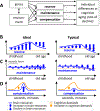Maintenance, reserve and compensation: the cognitive neuroscience of healthy ageing
- PMID: 30305711
- PMCID: PMC6472256
- DOI: 10.1038/s41583-018-0068-2
Maintenance, reserve and compensation: the cognitive neuroscience of healthy ageing
Erratum in
-
Author Correction: Maintenance, reserve and compensation: the cognitive neuroscience of healthy ageing.Nat Rev Neurosci. 2018 Dec;19(12):772. doi: 10.1038/s41583-018-0086-0. Nat Rev Neurosci. 2018. PMID: 30405175
-
Publisher Correction: Maintenance, reserve and compensation: the cognitive neuroscience of healthy ageing.Nat Rev Neurosci. 2018 Dec;19(12):772. doi: 10.1038/s41583-018-0087-z. Nat Rev Neurosci. 2018. PMID: 31586163
Abstract
Cognitive ageing research examines the cognitive abilities that are preserved and/or those that decline with advanced age. There is great individual variability in cognitive ageing trajectories. Some older adults show little decline in cognitive ability compared with young adults and are thus termed 'optimally ageing'. By contrast, others exhibit substantial cognitive decline and may develop dementia. Human neuroimaging research has led to a number of important advances in our understanding of the neural mechanisms underlying these two outcomes. However, interpreting the age-related changes and differences in brain structure, activation and functional connectivity that this research reveals is an ongoing challenge. Ambiguous terminology is a major source of difficulty in this venture. Three terms in particular - compensation, maintenance and reserve - have been used in a number of different ways, and researchers continue to disagree about the kinds of evidence or patterns of results that are required to interpret findings related to these concepts. As such inconsistencies can impede progress in both theoretical and empirical research, here, we aim to clarify and propose consensual definitions of these terms.
Conflict of interest statement
Competing interests
The authors declare no competing interests.
Figures



Comment in
-
Reply to 'Mechanisms underlying resilience in ageing'.Nat Rev Neurosci. 2019 Apr;20(4):247. doi: 10.1038/s41583-019-0139-z. Nat Rev Neurosci. 2019. PMID: 30814676 No abstract available.
-
Mechanisms underlying resilience in ageing.Nat Rev Neurosci. 2019 Apr;20(4):246. doi: 10.1038/s41583-019-0138-0. Nat Rev Neurosci. 2019. PMID: 30814677 No abstract available.
References
Publication types
MeSH terms
Grants and funding
LinkOut - more resources
Full Text Sources
Research Materials

